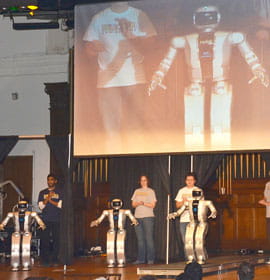Engineering Research Brings Seven Humanoid Robots to Drexel

Seven adult-sized humanoid robots took the stage during Drexel University’s celebration of National Engineers Week, in a first-of-its-kind assembly of robotic technology. A showcase event on Feb. 20 introduced all seven of the Korean HUBO robots to the community. Their presence -together in one place- is a unique event that serves as a key milestone for a nationwide, collaborative robotics research effort funded by the National Science Foundation.
Each robot is 1.3 meters, or about 4-feet, 3-inches, tall. They are fully actuated, which means that they have similar joints and movement capabilities to that of a human, including arms, legs and hands with fully functional fingers and an opposable thumb.
“This is an historic event,” said Dr. Youngmoo Kim, an associate professor and assistant dean of media technologies in the College of Engineering and the director of the Music and Entertainment Technology (MET) Lab. “Never before have seven adult-sized, fully actuated humanoids appeared on stage together, so it’s truly a milestone in robotics research.”
Roots of the Robot Project
This gathering of robots is the fruition of seeds planted in 2008 when Drexel received a five-year grant from the National Science Foundation’s Partnership for International Research and Education (PIRE) Program with the goal of training engineers to work in global multi-disciplined design teams. This project, in close collaboration with the Korea Advanced Institute of Science and Technology (KAIST) HUBO Lab, enables Drexel and KAIST researchers to share training and knowledge and to work with the same world-class humanoid robot platform from different continents.
Dr. Paul Oh , the head of the Mechanical Engineering and Mechanics department, who headed the initial HUBO robot research in 2008, helped bring the first humanoid robot, named Jaemi Hubo, to Drexel in the spring of 2009 as part of the NSF PIRE grant. Oh’s students traveled to Korea to work with the HUBO robot platform and learn how to program and operate the robots.
“Humanoids provide an exciting and practical context to both motivate and train American students,” Oh said. “One can argue that humanoids are the epitome of what one perceives to be a robot. As such, they are an attractive area for engineering students to work on. Students quickly learn that Asia is the world-leader in humanoid design. Thus to become humanoid designers, students recognize that working alongside robot engineers in Asia is important.”
“The KAIST Hubo served as an effective platform to train students in both complex systems engineering and working in international design teams. The net effect is that humanoids have been an effective medium to make today’s American engineer more effective in a globalized work environment.”
From One to Seven
Since the arrival of Jaemi Hubo in 2009, making Drexel the only institution in the United States to have full-access to an adult-sized humanoid, engineers in Drexel’s Autonomous Systems Lab (DASL) have been accumulating experience, knowledge, and best practices as well as training others for advanced humanoids research.
Drexel engineers have also pursued projects that enable the robot to interact more naturally with humans. Students in Drexel’s Music, Entertainment, Technology Laboratory (MET-lab) introduced algorithms that direct Jaemi Hubo to dance to music, play the piano, and accompany music with a tambourine. These efforts are part of research toward making the robot musically aware, which, according to Kim, places it on the path toward autonomous human interaction.
“Our world is designed by humans for humans. To be truly useful as assistive devices, robots need to be able to deal with all of the various challenges of the real world and must have the skills and abilities to interact appropriately with humans.”
In August of 2010, the NSF awarded a $6 million grant to a group of institutions led by Drexel to further advance humanoid robotics research in the United States. This Major Research Infrastructure (MRI) grant allowed six additional HUBO units to be brought to the United States.
“To date, all adult-sized humanoids have been individual custom-made units, and advances made using one design do not necessarily translate to others,” Kim said.
Since current humanoids are not ready for unconstrained interaction with humans, having a consistent platform will facilitate rapid progress in areas needed for autonomy and natural interaction, including mobility, manipulation, vision, speech communication and cognition, and learning.
Researchers from the seven collaborating schools, MIT, Carnegie Mellon, Virginia Tech, the University of Southern California, Ohio State, Purdue and Penn will travel to Drexel to receive training on operating the robots. Eventually, each robot will be sent off to its new home institution where researchers will be able to work directly the HUBO unit, while continuing to collaborate with their counterpart teams across the country.
“Our partners represent a critical mass of humanoids research and brainpower, and this effort will, for the first time, enable researchers to work with a common instrument,” Kim said. “Building upon the unique expertise we have developed at Drexel in assembling and maintaining HUBO, this project will rapidly advance the state of the art in humanoid robotics research.”
Taking the Next Step
From leading a game of “Simon Says” to recognizing and greeting administrators, the HUBO robot has already taken big steps toward autonomous human interaction. Part of Drexel’s role in the project is to outfit each robot with high fidelity sensors for audio, visual, and tactile sensing, as well as new software to integrate this sensory input from the environment. These new capabilities and the world-class research team involved in this partnership provide an ideal foundation for taking giant steps towards the development of fully interactive humanoids.
Ultimately, this MRI project facilitates potentially transformative advances in robotics, and eventually humanoid robotic assistants may become as commonplace as the Roomba robot vacuum cleaners. But achieving that goal requires advances spanning a broad range of areas and engineering of new technologies. Having access to a state-of-the-art humanoid platform enables US researchers to focus on our national strengths in artificial intelligence and human-robot interaction to make rapid progress towards truly useful robotic assistants.Drexel News is produced by
University Marketing and Communications.
